ALTERNATIVES
Medical Therapy
- Laser skin resurfacing reduces periorbital wrinkling but cannot address significant tissue redundancy or prolapse.
Surgery
- Browplasty: Brow ptosis (age-related sagging of the brows) may contribute significantly to sagging of the upper lid skin. Simultaneous lifting of forehead skin is therefore essential to a satisfactory surgical outcome in select cases.
- Ptosis repair: If significant blepharoptosis accompanies the lid tissue redundancy, simultaneous anterior levator advancement is advisable (see Chapter 7.7 Ptosis Repair).
RELEVANT ANATOMY/PATHOPHYSIOLOGY
Upper Lid Anatomy (FIG. 7.1.2)
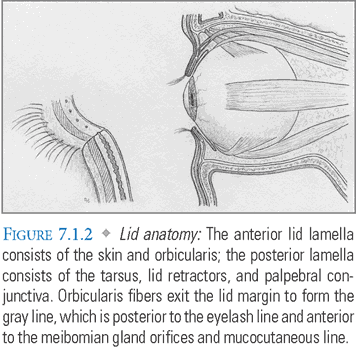
- Layers (superficial to deep): skin, minimal subcutaneous connective tissue, orbicularis, orbital septum, fat pads, aponeurosis of levator palpebrae superioris, Müller’s muscle, conjunctival fornix
- Eyelid crease: generally 8 to 10 mm above the lid margin in the mid-pupillary axis, though often lower or absent in Asians. It represents the most inferior extent of the orbital septum and fat pads as well as the insertion of levator aponeurosis fibers on the lid skin.
- Fat pads: There are two main upper lid fat pads—the nasal and the central. The nasal pad lies between the medial rectus and superior oblique, and is paler and firmer. The central pad overlies the levator aponeurosis and is separated from the nasal pad by fascial attachments to the trochlea.
Blepharochalasis
- A familial angioneurotic edema syndrome that causes periodic lid inflammation, especially in younger females. This leads to thinning and wrinkling of the periorbital skin.
- Important to distinguish from age-related changes, as it may recur after blepharoplasty.
PREOPERATIVE ASSESSMENT
- Photograph preoperative appearance and document current visual acuity.
- Functional blepharoplasty: Document visual fields before and after taping of the redundant skin (a demonstrable change is key to insurance reimbursement).
- Periorbital evaluation: Assess lid skin quality and degree of excess, amount and location of prolapsed orbital fat, lid crease position and symmetry, and lacrimal gland location.
- Since surgery can increase corneal exposure, evaluate for lagophthalmos, keratopathy, and adequacy of the tear film (check tear breakup time and perform the Schirmer’s test).
- Assess for blepharoptosis by measuring the palpebral fissure width and marginal reflex distance in primary gaze (FIG. 7.1.3).
- Assess for brow ptosis with a manual lift of the forehead skin. Significant improvement of lid skin redundancy may suggest the need for simultaneous browplasty.
- If conducting browplasty, assess forehead skin quality, as well as the position and shape of the brows, brow furrows, orbital rim, and hairline. These factors are important in selecting an appropriate surgical technique.

ANESTHESIA
- Mark the skin incisions prior to anesthetic infiltration as subcutaneous fluid will distort the lid contour.
- Infiltrate local anesthetic with epinephrine to aid hemostasis. It is critical to aspirate prior to injecting to preclude inadvertent intravascular release. Slow injection will limit the pain from lid distension.
PROCEDURE
 SEE TABLES 7.1.1 Rapid Review of Steps and 7.1.2 Surgical Pearls, and WEB TABLES 7.1.1 to 7.1.4 for equipment and medication lists.
SEE TABLES 7.1.1 Rapid Review of Steps and 7.1.2 Surgical Pearls, and WEB TABLES 7.1.1 to 7.1.4 for equipment and medication lists.


- Marking: An ellipse of upper lid skin is marked for removal. The lower margin of the ellipse is defined by the lid crease, which is typically 8 to 10 mm above the lash line in the midpupillary axis and 4 to 6 mm above it at the medial and lateral canthi. Redundant skin is overlapped with forceps to determine an appropriate upper resection margin. As a rule, at least 20 mm of skin should remain between the lower margin of the eyebrow and the lash line in order to prevent postoperative lid retraction (FIG. 7.1.4).
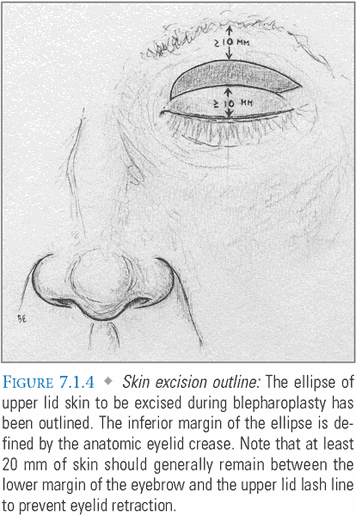
- Incision: After appropriate demarcation, the skin is incised to the level of the dermis while gentle traction is applied to the lid (FIG. 7.1.5). This can be accomplished with a traditional, laser, or radiofrequency scalpel. Beginning medially, the ellipse of skin is then dissected free with scissors or the scalpel, leaving the underlying orbicularis intact (FIG. 7.1.6). Careful hemostasis of the raw tissue bed is achieved with a bipolar cautery (FIG. 7.1.7).


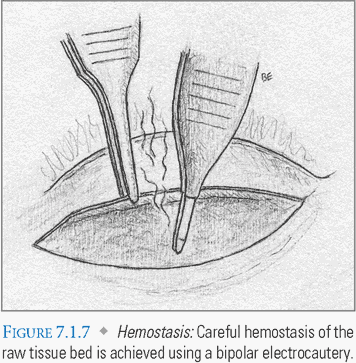
- Fat Pad Excision: The orbicularis is then divided just above the inferior margin of the elliptical incision, and the underlying orbital septum is incised, exposing the central and nasal fat pads (FIG. 7.1.8). Each pad is cross-clamped and divided while avoiding excessive traction, which can avulse vessels or damage adjacent orbital structures (FIG. 7.1.9). Meticulous hemostasis is maintained with electrocautery (FIG. 7.1.10). When excising the central fat pad, care is taken to prevent injury to the underlying levator aponeurosis.

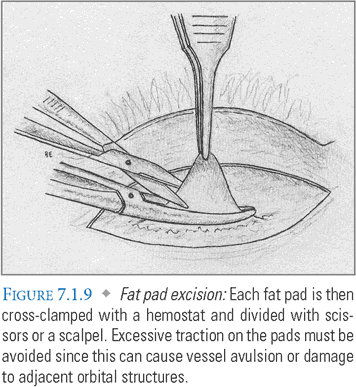

- Closure: The lid crease is reformed by tacking the skin to the levator aponeurosis with interrupted sutures placed at regular intervals (FIG. 7.1.11). Incorporation of the orbital septum is avoided, as this can result in postoperative lid retraction. The skin incision is then closed with a running nylon suture. A subcuticular stitch provides the best short-term cosmetic results, but the difference becomes less noticeable with time.
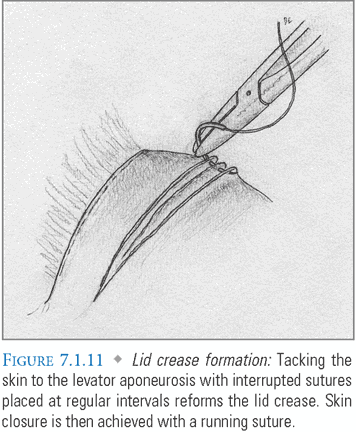
Additional Considerations: A browplasty requires the addition of supraorbital and supratrochlear regional blocks for adequate anesthesia. In general, an ellipse of skin is removed and the incision margins are reapproximated after they have been undermined to aid mobility. This results in vertical shortening of the forehead, eliminating brow ptosis. Several approaches are possible. See table below.
COMPLICATIONS
- Retrobulbar hemorrhage: Occurs from inadequate hemostasis or vessel avulsion due to excessive traction on the fat pads; can progress to permanent vision loss. Check visual acuity and pupillary responses to rule out optic nerve dysfunction. Also, evaluate the fundus for central retinal artery occlusion (CRAO), which can be precipitated by IOP increase due to compressive force of the hematoma. Perform an emergent lateral canthotomy/cantholysis for orbital decompression.
- Central retinal artery avulsion: A catastrophic complication due to excessive fat pad manipulation, which can produce retinal traction and vessel damage.
- Lid retraction: Excess skin removal can result in lagophthalmos and ocular exposure. Initially treat with lid massage and lubrication; surgical correction is necessary if significant exposure keratopathy develops.
- Superior oblique injury: The muscle is vulnerable to surgical trauma as it passes through the trochlea between the nasal and central fat pads.
- Lid bruising and discoloration: This is anticipated in all patients, but fades with time.
- Lid telangiectasias: May develop due to skin manipulation, but tend to fade with time.
- Lid hollowing: Fat pad resection changes the lid contour, so excessive removal of tissue should be avoided.
- Cysts/suture tracts: This can often be prevented with careful suture placement and early removal.
- Infection: This is rare because the lid is highly vascular with minimal soft tissue, so immune mediators are easily delivered.

POSTOPERATIVE CARE
- Periodically apply antibiotic ointment to the surgical wound.
- Give mild oral analgesics since uncomplicated lid surgery should cause only minor discomfort.
- Counsel the patient to report severe pain immediately. This may be a sign of retrobulbar hemorrhage or corneal abrasion.
- Apply cold packs for the first 48 hours, then heat until the swelling resolves.
- Remove the skin sutures at 5 to 7 days for optimal cosmetic results.
- Avoid anticoagulants for 1 to 2 weeks, control blood pressure, and caution the patient to avoid straining (e.g., heavy lifting, Valsalva).
Further Reading
Text
Ben Simon GJ, McCann JD. Cosmetic eyelid and facial surgery. Surv Ophthalmol. 2008;53(5):426–442.
Codere F, Tucker N. Cosmetic blepharoplasty and browplasty. In: Yanoff M, Duker J, eds. Ophthalmology. 3rd ed. Philadelphia, PA: Mosby; 2009:1488–1495.
Gentile RD. Upper lid blepharoplasty. Facial Plast Surg Clin North Am. 2005;13(4):511–524, v–vi.
Patrocinio LG, Patrocinio JA. Forehead-lift: a 10-year review. Arch Facial Plast Surg. 2008;10(6):391–394.
Purewal BK, Bosniak S. Theories of upper eyelid blepharoplasty. Ophthalmol Clin North Am. 2005;18(2): 271–398, vi.
Tasman W, Jaeger E, eds. Blepharoplasty. In: Duane’s Clinical Ophthalmology. Vol 5. Philadelphia, PA: Lippincott Williams & Wilkins; 2008:chap 74.
Wagner P, Lang GK. The eyelids. In: Ophthalmology: A Pocket Textbook Atlas. 2nd ed. New York, NY: Georg Thieme Verlag; 2007:17–49.
Primary Sources
Kashkouli MB, Kaghazkanai R, Mirzaie AZ, et al. Clinicopathologic comparison of radiofrequency versus scalpel incision for upper blepharoplasty. Ophthal Plast Reconstr Surg. 2008;24(6):450–453.
Kim HH, De Paiva CS, Yen MT. Effects of upper eyelid blepharoplasty on ocular surface sensation and tear production. J Ophthalmol. 2007;42(5):739–742.
7.2DACRYOCYSTORHINOSTOMY (DCR)
- An occluded nasolacrimal duct is bypassed by creating an alternative drainage route between the lacrimal sac and nasal mucosa.
- This is most often performed through a skin incision, which permits the creation of an epithelium-lined tract. Nasal endoscopic alternatives are also available.
INDICATIONS
- Persistent obstruction of the nasolacrimal duct after an adequate trial of conservative therapy
- Bony obstruction of the duct, which cannot be ameliorated by medical therapy
ALTERNATIVES
Medical Therapy
Congenital Obstruction
- In the first year of life, 90% resolve spontaneously and are managed conservatively with lacrimal sac massage. If necessary, persistent membranes can be perforated with lacrimal drainage system probing.
Acquired Obstruction
- Dacryocystitis with obstruction is initially treated with antistaphylococcal antibiotics. Transcutaneous aspiration of the lacrimal sac to obtain culture specimens ensures adequate coverage of resistant organisms. Postinfectious epiphora can often be ameliorated with a trial of drainage system probing and syringing.
- Sympathomimetic vasoconstrictors (e.g., naphazoline) temporarily shrink the nasal mucosa and free mucus plugs, if present.
- Balloon dacryoplasty with placement of bicanalicular silicon tubing is an effective short-term management strategy, but stenosis generally recurs.
- Etiology-specific treatments are given (e.g., corticosteroids for sarcoidosis).
Surgery
Endoscopic nasal procedures do not require external incisions, but create drainage tracts that are smaller than those created via an external approach. Restenosis rates are consequently higher, but continue to improve with refinements in technique.
RELEVANT PHYSIOLOGY/ANATOMY
Nasolacrimal Physiology/Anatomy
- Disruption of the balance between tear production and drainage leads to a dry or watery eye (epiphora).
- Tear production:
- Lacrimal gland:
- Located in the supertemporal orbit beneath the orbital rim
- Divided into orbital and palpebral segments by the levator aponeurosis
- Creates the middle, aqueous (watery) layer of the tear film, which maintains a smooth corneal refractive surface and mobile conjunctiva
- Located in the supertemporal orbit beneath the orbital rim
- Accessory glands: the glands of Krause and Wolfring in the superior fornix supplement lacrimal gland tear production
- Lacrimal gland:
- Tear drainage:
- “Windshield wiper” lid motion: Contraction of the orbicularis begins laterally, resulting in medial movement of tear fluid.
- Tear lake/meniscus: Fluid accumulates in the inferior fornix near the medial canthus. The inferior punctum is normally submerged in this “lake.”
- Mechanism: Tears enter the puncta via capillary action and then drain due to the force of gravity and the canalicular pumping generated by contraction of the surrounding orbicularis.
- Lacrimal drainage route: tear lake superior and inferior puncta superior and inferior canaliculi common canaliculus nasolacrimal sac nasolacrimal duct exit through an ostium in the nasal mucosa beneath the inferior nasal turbinate (FIG. 1A)
- Nasolacrimal sac: A mucosal pouch that is located in the lacrimal fossa, a bony depression between the anterior and posterior lacrimal crests. The crests are formed by the frontal process of the maxilla and the lacrimal bone, respectively (FIG. 1A, B). The angular artery, a distal branch of the facial artery, lies just medial to the anterior lacrimal crest and is frequently encountered during surgery.

- “Windshield wiper” lid motion: Contraction of the orbicularis begins laterally, resulting in medial movement of tear fluid.
Causes of Epiphora
- Anatomic: A stricture, obstruction, foreign body, or tumor that blocks the nasolacrimal drainage system.
- Physiologic: A weak or paralyzed orbicularis that inhibits the tear-pumping mechanism; malposition of the lids and puncta (e.g., due to ectropion) can prevent tear entry into an otherwise patent drainage system.
- Note: Epiphora can also be seen in the absence of lacrimal drainage abnormalities. Reflex hypersecretion may occur in response to dry eye conditions or other forms of ocular surface irritation.
Classification of Obstruction
Congenital
- Due to an imperforate membrane or incomplete bony canalization in the lower drainage system
Acquired
- Idiopathic: inflammation, vascular congestion, lymphocyte infiltration, and edema develop due to an unknown cause and ultimately result in fibrosis
- Inflammatory: due to sarcoidosis, Wegener’s granulomatosis, etc.
- Infectious: due to staphylococcus, streptococcus, pseudomonas, tuberculosis (TB), etc.
- Traumatic/postsurgical: can manifest after nasoethmoid fracture, sinus surgery, rhinoplasty, orbital decompression, etc.
- Malignant: due to primary lacrimal sac tumors, benign papilloma, squamous/basal cell carcinoma, lymphoma, etc.
PREOPERATIVE SCREENING
- Dye disappearance test (DDT): After topical anesthetic application, fluorescein dye is placed in the inferior fornix and the tear lake is observed with the slit lamp, using the cobalt filter. The presence of residual dye after 5 minutes suggests defective nasolacrimal drainage.
- Jones fluorescein dye test: Fluorescein is placed in the inferior fornix and the nose is examined for dye at 5 minutes. If none appears, the lacrimal sac is cannulated and irrigated with saline. Failure of dye to appear in the nose after irrigation indicates obstruction, whereas limited appearance of dye suggests stenosis.
- Lacrimal syringing: An irrigation cannula is introduced into the inferior punctum and advanced through the canaliculus. If the tip stops against bone (the floor of the lacrimal fossa), it has entered the nasolacrimal sac and the upper system is patent. If the tip stops against soft tissue, the upper system is obstructed. Saline is then infused; drainage into the nose without resistance or reflux confirms that the lower drainage system is also patent.
- Dacryocystography (DCG): This technique is occasionally used to assess patency of the nasolacrimal drainage system. Water-soluble contrast is infused prior to acquisition of digital subtraction X-ray or computed tomography (CT) scan.
- Nasal endoscopy: This technique permits observation of the nasolacrimal duct ostium.
ANESTHESIA
- A local block of the infratrochlear and anterior ethmoidal nerves is often used in conjunction with monitored anesthesia care (MAC). General anesthesia may be substituted.
PROCEDURE
 SEE TABLES 7.2.1 Rapid Review of Steps and 7.2.2 Surgical Pearls, and WEB TABLES 7.2.1 to 7.2.4 for equipment and medication lists.
SEE TABLES 7.2.1 Rapid Review of Steps and 7.2.2 Surgical Pearls, and WEB TABLES 7.2.1 to 7.2.4 for equipment and medication lists.

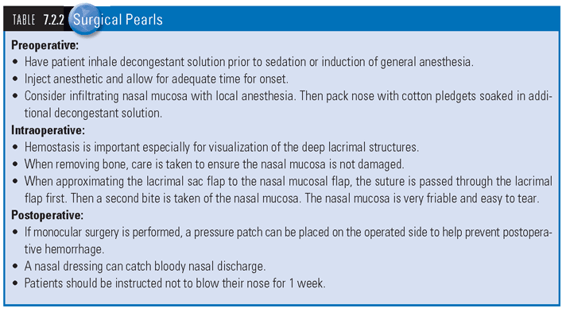
- Preoperative medication: Nasal packing soaked with a sympathomimetic vasoconstrictor (e.g., naphazoline or cocaine) is inserted into the ipsilateral nare to reduce intraoperative bleeding (FIG. 2). Some surgeons infuse methylene blue dye into the nasolacrimal system to outline the lacrimal sac mucosa.

- Primary incision: Classically, a vertical incision is made on the lateral portion of the bridge of the nose inferior to the medial canthal tendon. It is placed 10 mm medial to the canthal angle to avoid the angular vessels, which lie approximately 8 mm medial to this landmark. In practice, a more lateral curvilinear incision overlying the anterior lacrimal crest provides better exposure of the fossa. The underlying angular vessels can be cauterized and cut without adverse consequences due to the presence of collateral circulation (FIGS. 3–5).
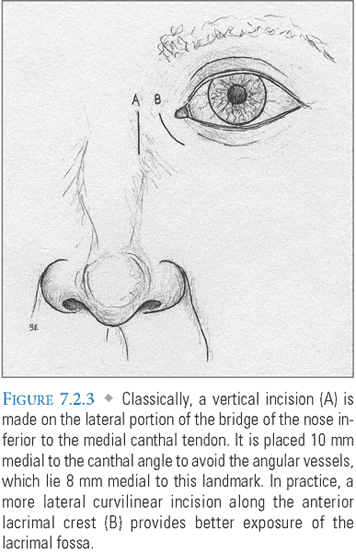
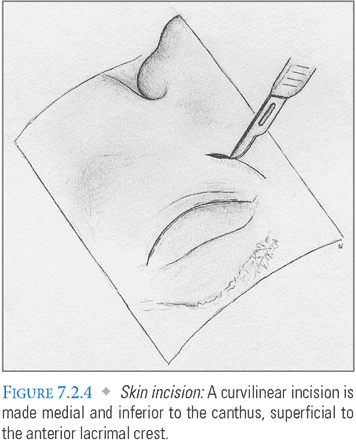
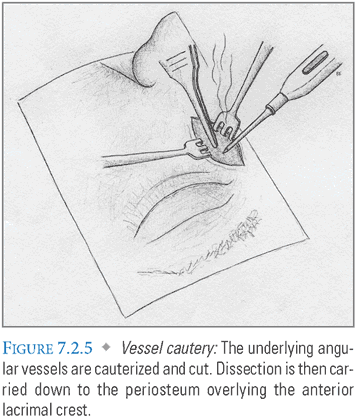
- Lacrimal sac fossa exposure: The orbicularis is then divided, and the dissection is carried down to the underlying periosteum, which is also incised. The periosteum is reflected laterally from the anterior lacrimal crest with a periosteal elevator, revealing the sac within the lacrimal sac fossa (FIGS. 6–7). The lacrimal sac is then retracted within an envelope of periosteum to expose the fossa floor (FIG. 8).
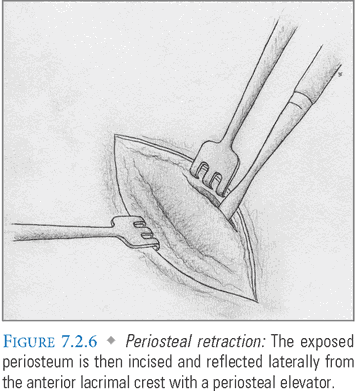
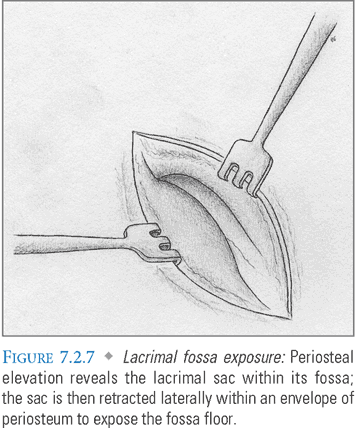
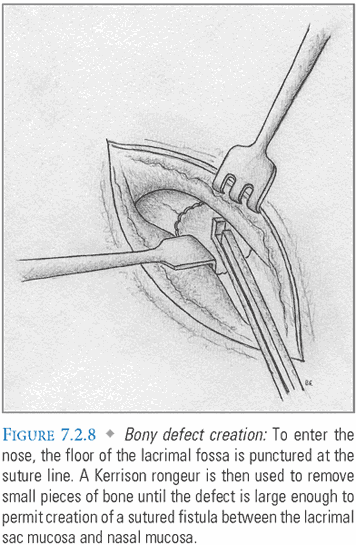
- Bone removal: To enter the nose, the floor of the lacrimal fossa is punctured at the suture line between the frontal process of maxilla and the lacrimal bone. A Kerrison rongeur is then used to remove small pieces of bone until the defect is large enough to permit the creation of a sutured fistula between the lacrimal sac mucosa and nasal mucosa (FIG. 9). In this location, the maxilla is thicker than the lacrimal bone, so natural variations in suture location influence how much bone must be removed.

- Tract creation and stenting: Probes connected by silicone tubing are inserted through the superior and inferior puncta into the lacrimal sac. The medial wall of the sac is then incised over the probe tips, creating anterior and posterior mucosal flaps (FIG. 10). The nasal mucosa underlying the bony defect is also incised, creating anterior and posterior flaps (FIG. 11). A suction tip is then introduced into the nose and passed through the defect in the fossa floor. It is used to guide passage of the punctal probes and attached silicon tubing (FIG. 12). The mucosal flaps are then sutured posterior-to-posterior, and anterior-to-anterior to create an epithelium-lined tract (FIG. 13). Some surgeons omit posterior flap sutures, instead choosing to excise the excess mucosal tissue. The punctal probes are then detached from the silicone tubing. The free ends of the tubing are knotted together and trimmed. This knot will retract within the nare due to elastic recoil. The silicone stent is left in place for several weeks to ensure that the tract remains patent.
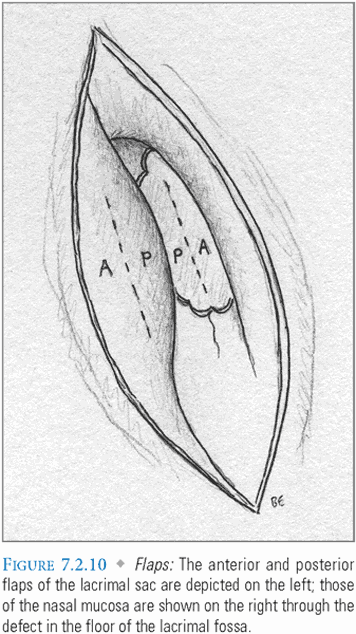
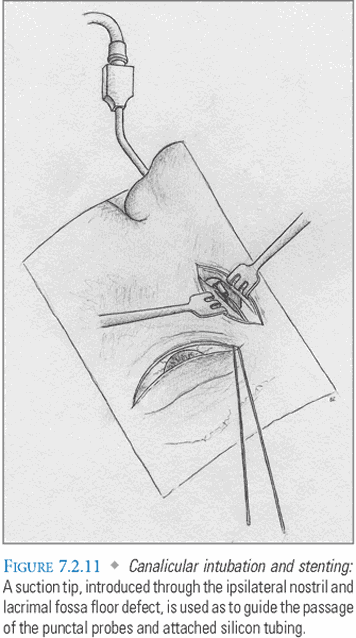
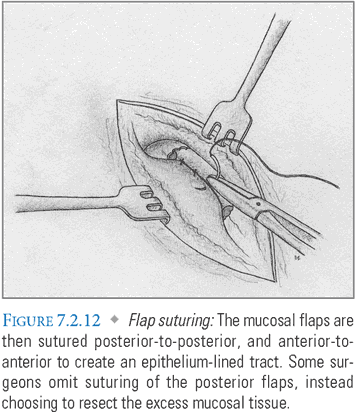
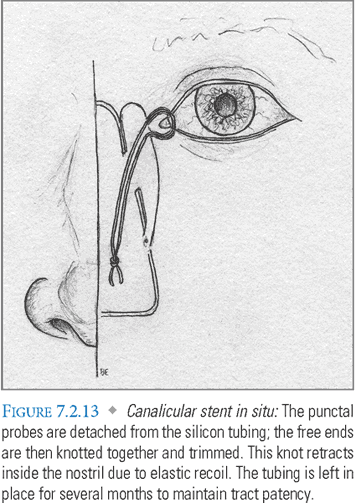
- Closure: The periosteum and orbicularis are reapposed with interrupted sutures. The skin is then closed with a running suture.
Endoscopic surgery: A light pipe is threaded through the inferior punctum and into the lacrimal sac. The nasal mucosa is then incised around the spot of light that shines through the lacrimal fossa floor. The bone is punctured with a burrtip drill and the defect is enlarged with a Kerrison rongeur. The exposed medial wall of the lacrimal sac is incised and partially removed with scissors. Because epithelial flaps are generally not created, fistula patency must initially be maintained with an indwelling silicon stent.
COMPLICATIONS
Intraoperative
- Hemorrhage: Bleeding can be limited by cauterizing the angular veins with care, controlling systemic blood pressure, pretreating with vasoconstrictors, and using nasal packing to tamponade the mucosa.
Postoperative
- Failure to maintain patency: Administering decongestant and corticosteroid sprays can help shrink granulation tissue. Drainage system probing should be attempted prior to surgical revision.
POSTOPERATIVE CARE
- Apply topical antibiotics to the surgical wound for 1 week, and prescribe an oral antistaphylococcal antibiotic (e.g., first generation cephalosporin).
- Remove the skin suture at 5 to 7 days for optimal cosmetic results.
- Remove the silicon tubing at 6 to 12 weeks.
Further Reading
Text
Athanasiov PA, Prabhakaran VC, Mannor G, et al. Transcanalicular approach to adult lacrimal duct obstruction: a review of instruments and methods. Ophthalmic Surg Lasers Imaging. 2009;40(2):149–159.
Hurwitz JJ. The lacrimal drainage system. In: Yanoff M, Duker J, eds. Ophthalmology. 3rd ed. Philadelphia, PA: Mosby; 2009:1482–1488.
Mandeville JT, Woog JJ. Obstruction of the lacrimal drainage system. Curr Opin Ophthalmol. 2002;13(5): 303–309.
Wagner P, Lang GK. Lacrimal system. In: Ophthalmology: A Pocket Textbook Atlas. 2nd ed. New York, NY: Georg Thieme Verlag; 2007:49–66.
Watkins LM, Janfaza P, Rubin PA. The evolution of endonasal dacryocystorhinostomy. Surv Ophthalmol. 2003;48(1):73–84.
Primary Sources
Feretis M, Newton JR, Ram B, et al. Comparison of external and endonasal dacryocystorhinostomy. J Laryngol Otol. 2009;123(3):315–319.
Kansu L, Aydin E, Avci S, et al. Comparison of surgical outcomes of endonasal dacryocystorhinostomy with or without mucosal flaps. Auris Nasus Larynx. 2009;36(5): 555–559.
Seider N, Kaplan N, Gilboa M, et al. Effect of timing of external dacryocystorhinostomy on surgical outcome. Ophthal Plast Reconstr Surg. 2007;23(3):183–186.
Umapathy N, Kalra S, Skinner DW, et al. Long-term results of endonasal laser dacryocystorhinostomy. Otolaryngol Head Neck Surg. 2006;135(1):81–84.
- Restores an everted lower lid margin and punctum to normal positions in relation to the globe by addressing specific anatomic defects.
- Repair often entails shortening the tarsus, canthal tendons, or posterior lamella. Less commonly, the anterior lamella must be lengthened.
- Repair of the primary anatomic defect is prioritized, but it may be necessary to combine multiple techniques to achieve satisfactory results.
INDICATIONS
- Corneal breakdown due to lagophthalmos and ocular exposure.
- In the treatment of facial nerve palsy, ectropion repair is often combined with upper lid reanimation procedures such as gold weight or palpebral spring implantation.
ALTERNATIVES
Medical Therapy
- Lubrication: Artificial tears and ointments are used for mild disease.
- Bell’s palsy: Ectropion is generally self-limited and administration of oral acyclovir may hasten recovery.
Surgery
- Electrocautery: Cautery spots are applied to the palpebral conjunctiva, which results in forniceal fibrosis and shortening, thus reapposing the lid to the globe. Better results are usually achieved by correcting specific anatomic defects.
- Tarsorrhaphy: If ectropion is associated with facial nerve palsy and “BAD syndrome” (absent Bell’s phenomenon, Anesthetic corneas, and Dry eyes), suture tarsorrhaphy may be advisable to protect against acute corneal decompensation (see Chapter 7.8 Tarsorrhaphy).
RELEVANT PHYSIOLOGY/ANATOMY
Ectropion Overview
- The lower lid margin is everted from the globe. This leads to lagophthalmos and corneal exposure.
- Eversion of the punctum from the inferior fornix tear lake (lacus lacrimalis) inhibits nasolacrimal drainage. This causes tear fluid to run onto the cheek (epiphora).
- Poor tear drainage is exacerbated by lid laxity and loss of orbicularis tone, which eliminate the pumping mechanism (flaccid canalicular syndrome).
- If reflex tearing is inadequate to moisten the cornea, the patient will develop superficial punctate keratitis (SPK), which can progress to ulceration, superinfection, and perforation.
Ectropion Classification
- Involutional: Caused by age-related stretching of the tarsus and palpebral ligaments, and is the most common form. It generally progresses from punctal eversion to medial ectropion to generalized ectropion.
- Paralytic: Facial nerve palsy results in unilateral loss of orbicularis tone, which unmasks lid laxity. Paralysis may be temporary (e.g., Bell’s palsy associated with Lyme disease, sarcoidosis, diabetes, or acquired immune deficiency syndrome [AIDS]) or permanent (e.g., trauma, surgery, or stroke affecting facial motor nucleus).
- Cicatricial: Insults such as burns, infection, and prior surgery may result in lid eversion due to scarring and contraction of the anterior lamella. This is exacerbated by coexisting horizontal laxity or lid retractor disinsertion.
- Congenital: A rare form of entropion caused by eyelid skin shortage. It is frequently associated with Down syndrome or blepharophimosis syndrome, but may also be idiopathic.
- Floppy eyelid syndrome: This is most frequently seen in overweight males with obstructive sleep apnea. Extreme lid tissue laxity is accompanied by tarsal thickening and chronic low-grade inflammation.
Lower Lid Anatomy
“Tarsoligamentous Sling” (FIG. 7.3.1)

- Formed by the inferior tarsus and canthal tendons, which keep the lid margin apposed to the globe. Any or all components can develop laxity, resulting in ectropion.
- Inferior tarsus: a dense connective tissue plate, approximately 1-mm thick and 4-mm wide in the midpupillary axis.
- Medial canthal tendon: divided into two limbs; the anterior limb anchors the medial tarsus and canthal angle to the frontal process of the maxilla (anterior lacrimal crest) while the posterior limb anchors these structures to the lacrimal bone (posterior lacrimal crest). The limbs flank the lacrimal sac, which sits in the nasolacrimal fossa.
- Lateral canthal tendon: anchors the lateral tarsus and canthal angle to Whitnall’s tubercle on the inner margin of the lateral orbital rim. Other structures inserting on Whitnall’s tubercle include Lockwood’s ligament, the lateral check ligament, and the lateral horn of the LPS.
- Inferior tarsus: a dense connective tissue plate, approximately 1-mm thick and 4-mm wide in the midpupillary axis.
Lower Lid Lamellae
- Anterior lamella: consists of the lid skin and orbicularis oculi.
- Posterior lamella: consists of the inferior tarsus, capsulopalpebral fascia, and palpebral conjunctiva.
- Length imbalance between the anterior and posterior lamellae can result in lid eversion (e.g., cicatricial ectropion).
Capsulopalpebral Fascia
- Formed by the lower lid retractors, which oppose the action of the orbicularis muscle (analogous to the levator palpebrae superioris).
- Originates as an extension of the inferior rectus sheath and inserts on the inferior tarsus. This explains the depression of the lower lid in downgaze.
- Condenses to form Lockwood’s ligament, which helps to support the globe within the orbit.
- Smooth muscle components receive sympathetic innervation; disruption results in “reverse ptosis.”
PREOPERATIVE SCREENING
- Exam: Identify specific anatomic defect(s) and evaluate the severity of ectropion, lagophthalmos, and corneal pathology.
- Snap test: Pull the lower lid down and away from the globe; then assess the speed of return after release (should occur spontaneously within 1 blink).
- Horizontal laxity: Pull the lid away from the globe (more than 10 mm of excursion is abnormal).
- Medial canthal tendon laxity: Pull the lid laterally and check movement of the inferior punctum (normally ≤ 1 to 2 mm).
- Lateral canthal tendon laxity: The lateral canthus should form an acute angle from 1 to 2 mm medial to orbital rim. Pull the lid medially and check movement of the angle (normally ≤ 1 to 2 mm).
- Punctal position: The inferior punctum should not be visible without manual lid eversion since it is normally submerged within the tear lake.
- Lid retractor laxity/disinsertion: Results in decreased motion of the lower lid on downgaze as well as an abnormally high resting position. Sympathetic denervation may also elevate the resting position of the lid, but should not impact motion on downgaze.
- Cicatricial changes: Observe the lower lid skin for discrete scars and check to see if tension lines form when the lid is pushed against the globe (indicates diffuse contracture).
- Orbicularis/facial nerve: Check tone during forced eye closure as well as observe for lid retraction, loss of forehead wrinkling, and mouth drop.
- Conduct a slit lamp exam with fluorescein to assess for exposure keratitis.
- Snap test: Pull the lower lid down and away from the globe; then assess the speed of return after release (should occur spontaneously within 1 blink).
ANESTHESIA
- Local infiltration of anesthetic containing epinephrine to aid hemostasis
PROCEDURE
A procedure is chosen based on the anatomic defects present and the severity of disease. Although there is some overlap, these procedures can be grouped into five conceptual categories: shortening of the lateral canthal tendon, medial canthal tendon, horizontal lid, or posterior lamella, and lengthening of the anterior lamella.
- Lateral Canthal Tendon Shortening:
 Lateral Tarsal Strip: Corrects lateral canthal tendon and horizontal lid laxity. (SEE TABLES 7.3.1 Rapid Review of Steps and 7.3.2 Surgical Pearls, and WEB TABLES 7.3.1 to 7.3.4 for equipment and medication lists).
Lateral Tarsal Strip: Corrects lateral canthal tendon and horizontal lid laxity. (SEE TABLES 7.3.1 Rapid Review of Steps and 7.3.2 Surgical Pearls, and WEB TABLES 7.3.1 to 7.3.4 for equipment and medication lists).
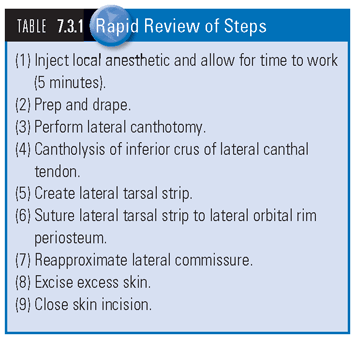

- Canthotomy/Cantholysis: A horizontal skin incision is made beginning at the lateral canthus (FIG. 7.3.2). The lateral commissure is then incised with laterally directed scissors (FIG. 7.3.3: Canthotomy). The inferior arm of the canthal tendon is placed on tension with forceps and transected with scissors directed toward the patient’s nose (FIG. 7.3.4: Cantholysis). Completion of these steps result in full lower lid mobilization (FIG. 7.3.5).
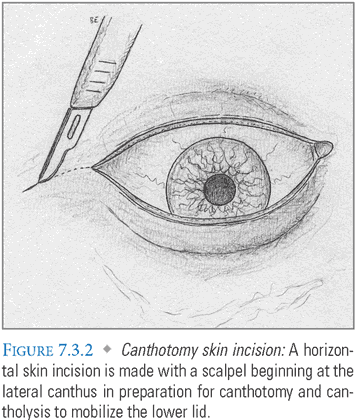
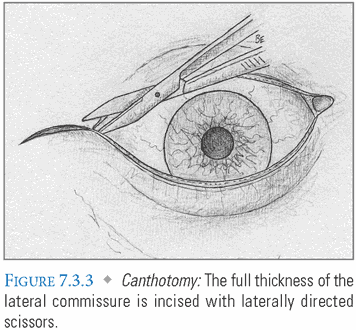
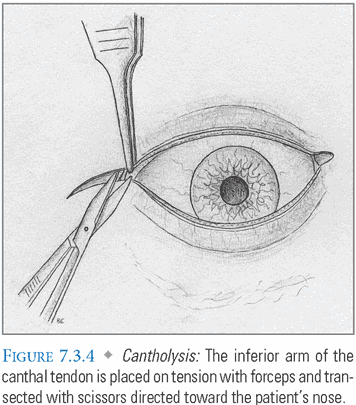
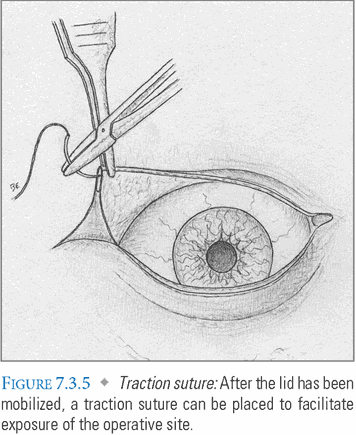
- Orbital Rim Exposure: The orbicularis is then divided and the periosteum overlying the lateral orbital rim is exposed with blunt dissection.
- Tarsal Strip Formation: The lid margin, retractors, and anterior lamellar layers are removed with sharp dissection to expose a strip of the lateral tarsal plate (FIG. 7.3.6). The palpebral conjunctiva overlying this strip is then scraped away with a scalpel (FIG. 7.3.7).

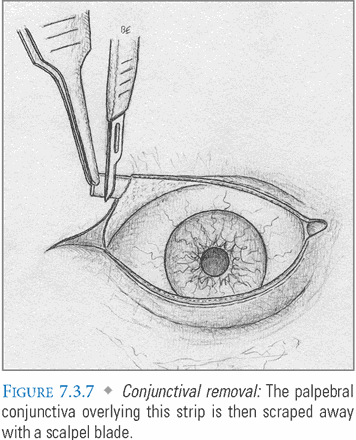
- Lid Tightening: A suture is passed through the anterior margin of the strip and then through periosteum overlying Whitnall’s tubercle (FIGS. 7.3.8A,B). Tightening this suture reapposes the lid to the globe.

- Closure: Passing a suture through the lateral margins of the upper and lower lids reforms the commissure (FIG. 7.3.9). Care is taken to realign the gray lines. The canthotomy incision is then closed in layers.
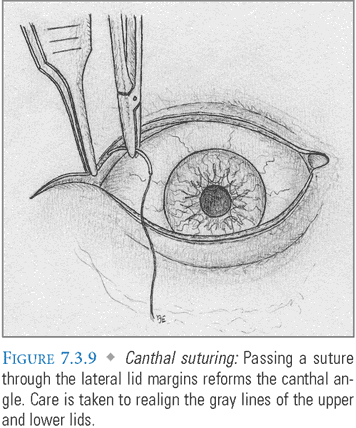
- Canthotomy/Cantholysis: A horizontal skin incision is made beginning at the lateral canthus (FIG. 7.3.2). The lateral commissure is then incised with laterally directed scissors (FIG. 7.3.3: Canthotomy). The inferior arm of the canthal tendon is placed on tension with forceps and transected with scissors directed toward the patient’s nose (FIG. 7.3.4: Cantholysis). Completion of these steps result in full lower lid mobilization (FIG. 7.3.5).
- Medial Canthal Repairs:
- Medial Canthal Tendon Plication: This is used for mild tendon laxity without canthal angle displacement. It is frequently combined with other horizontal shortening procedures.
- Incision: A punctal probe is placed in the inferior canaliculus to aid intraoperative identification and prevent inadvertent transection. A horizontal skin incision is then made below the medial canthus.
- Plication: After dividing the orbicularis, the tarsal insertion of the medial canthal tendon is exposed. A suture is passed from the medial tarsus to the anterior limb of the tendon, and tightened to stabilize the canthal angle. The skin incision is then closed.
- Incision: A punctal probe is placed in the inferior canaliculus to aid intraoperative identification and prevent inadvertent transection. A horizontal skin incision is then made below the medial canthus.
- Medial Canthal Angle Resection: Used for pronounced medial tendon laxity with angle displacement. Aggressive tendon plication alone would kink the inferior canaliculus, preventing tear drainage.
- Incision: A punctal probe is placed in the inferior canaliculus to aid intra-operative identification. A full-thickness vertical lid incision is then made medial to the inferior punctum. The canaliculus is transected, as is the canthal tendon. The incision is then extended onto the bulbar conjunctiva.
- Tightening: The posterior lacrimal crest is exposed with blunt dissection and a double-armed suture is passed through the overlying periosteum. The lid is pulled medially, and an appropriate amount is excised. The suture needles are then passed through the medial tarsus, effectively replacing the cut posterior limb of the canthal tendon.
- Canalicular Fistula: To permit tear drainage, a fistula is created between the inferior fornix and the distal canaliculus, which remains connected to the nasolacrimal duct.
- Closure: The suture connecting the posterior lacrimal crest and medial tarsus is tightened and tied. The lid margin and skin are then reapproximated with sutures.
- Incision: A punctal probe is placed in the inferior canaliculus to aid intra-operative identification. A full-thickness vertical lid incision is then made medial to the inferior punctum. The canaliculus is transected, as is the canthal tendon. The incision is then extended onto the bulbar conjunctiva.
- Medial Canthal Tendon Plication: This is used for mild tendon laxity without canthal angle displacement. It is frequently combined with other horizontal shortening procedures.
- Horizontal Lid Shortening:
- Full-thickness Resection: Corrects tarsal laxity.
- Incision: Angled incisions through the tarsus would result in lid notching and tear film disruption. A full thickness “pentagon” of tissue is therefore removed (FIG. 7.3.10). The tarsus and overlying skin are transected perpendicular to the lid margin. The incisions are then angled to meet at an apex in the inferior fornix.

- Closure: The tarsal plate and lid retractors are reapproximated with partial-thickness absorbable sutures. To ensure even lid margin healing, additional sutures are passed through the gray line and lash line (FIG. 7.3.11). The tails are left long to permit easy identification and prevent corneal abrasion. Lid skin is then closed with interrupted sutures.

- Incision: Angled incisions through the tarsus would result in lid notching and tear film disruption. A full thickness “pentagon” of tissue is therefore removed (FIG. 7.3.10). The tarsus and overlying skin are transected perpendicular to the lid margin. The incisions are then angled to meet at an apex in the inferior fornix.
- Lazy-T: Corrects coexisting horizontal lid laxity and punctal eversion. Combines full-thickness lid tissue resection (see previous) with tarsoconjunctival excision (see following).
- Full-thickness Resection: Corrects tarsal laxity.
- Posterior Lamellar Shortening:
- Tarsoconjunctival Excision: Localized vertical shortening of the posterior lamella corrects medial ectropion with punctal eversion.
- Incision: The lid is everted after insertion of a punctal probe to protect the inferior canaliculus. A diamond-shaped segment of tarsus and overlying conjunctiva is then removed inferior to the punctum (FIG. 7.3.12). The superior incision should be at least 2 mm below the lid margin to prevent canalicular injury during suture passage.
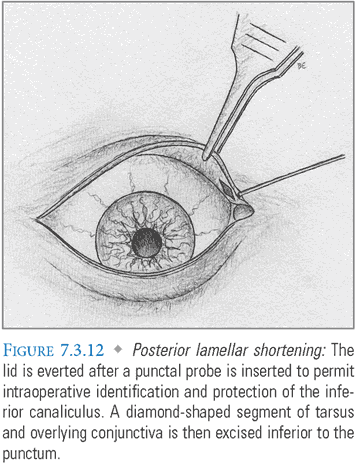
- Closure: Closing the defect with absorbable sutures shortens the posterior lamella, reapposing the medial lid and punctum with the globe. Care is taken to bury the knots to avoid ocular surface irritation (FIG. 7.3.13).
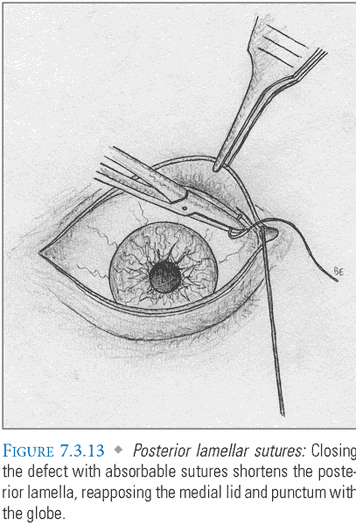
- Incision: The lid is everted after insertion of a punctal probe to protect the inferior canaliculus. A diamond-shaped segment of tarsus and overlying conjunctiva is then removed inferior to the punctum (FIG. 7.3.12). The superior incision should be at least 2 mm below the lid margin to prevent canalicular injury during suture passage.
- Tarsoconjunctival Excision: Localized vertical shortening of the posterior lamella corrects medial ectropion with punctal eversion.
- Anterior Lamellar Lengthening:
- Z Plasty: Flap rearrangement corrects shortening due to a focal linear scar.
- Incision: A lid margin traction suture is placed through the meibomian gland orifices. A “Z” with arms that intersect at 60-degree angles is then marked over the scar and traced with a scalpel. The resulting flaps are undermined to permit mobilization (FIG. 7.3.14A).
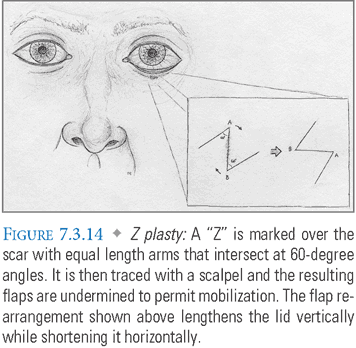
- Closure: After scar tissue is excised, the flaps are transposed and closed with interrupted sutures (FIG. 7.3.14B). This rearrangement lengthens the lid vertically while shortening it horizontally.
NOTE: If the scar involves the lid margin itself, full thickness excision must be performed as previously described.
- Incision: A lid margin traction suture is placed through the meibomian gland orifices. A “Z” with arms that intersect at 60-degree angles is then marked over the scar and traced with a scalpel. The resulting flaps are undermined to permit mobilization (FIG. 7.3.14A).
- Pedicle Transposition Flap: Excess upper lid skin is transposed to correct cicatricial lower lid ectropion. The pedicle can originate from either canthus.
- Incision: A lower lid margin traction suture is placed. The proposed upper lid flap and lower lid incision are then marked. The flap should overlie the upper lid crease so that the defect will be well hidden after closure. The lower lid incision is made with a scalpel. Scar tissue is excised and the wound margins are undermined to permit mobilization (FIG. 7.3.15). Applying tension to the traction suture reveals the full size of the defect.
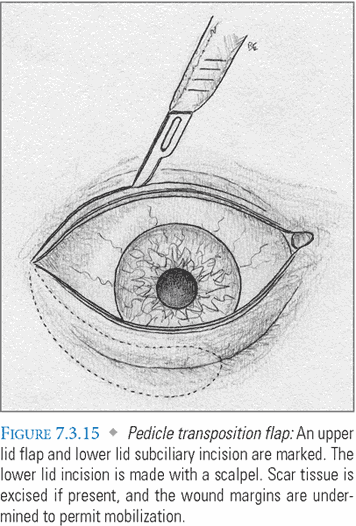
- Flap Rotation: The upper lid flap is outlined with a scalpel. The free end is then undermined and rotated into the lower lid defect (FIG. 7.3.16).
- Closure: All skin incisions are closed with suture and covered with a pressure dressing for 24 hours.
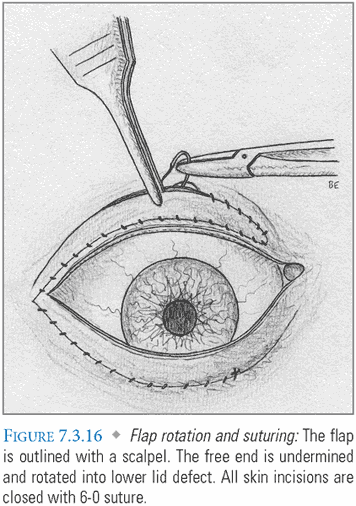
- Incision: A lower lid margin traction suture is placed. The proposed upper lid flap and lower lid incision are then marked. The flap should overlie the upper lid crease so that the defect will be well hidden after closure. The lower lid incision is made with a scalpel. Scar tissue is excised and the wound margins are undermined to permit mobilization (FIG. 7.3.15). Applying tension to the traction suture reveals the full size of the defect.
- Skin Graft: A graft is used to correct severe ectropion due to diffuse skin shortage.
- Incision: Traction sutures are placed through the lid margin, and a horizontal incision is made 2 to 3 mm below the lash line (FIG. 7.3.17). The wound margins are then undermined and scar tissue is excised. Applying tension to the traction sutures reveals the full size of the lower lid defect.

- Donor Site Resection: The defect is then used to create a template for donor site resection. Postauricular, inner arm, and jugular notch skin provide good color and thickness matches.
- Graft Placement: After the graft is removed from the donor bed and small stab incisions are made to permit drainage, it is sutured into place and covered with a compression dressing (FIG. 7.3.18).
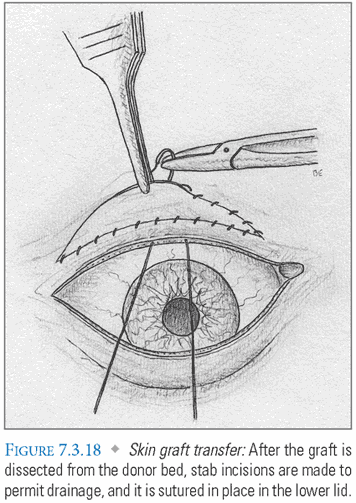
- Incision: Traction sutures are placed through the lid margin, and a horizontal incision is made 2 to 3 mm below the lash line (FIG. 7.3.17). The wound margins are then undermined and scar tissue is excised. Applying tension to the traction sutures reveals the full size of the lower lid defect.
- Z Plasty: Flap rearrangement corrects shortening due to a focal linear scar.
NOTE: The graft must be slightly larger than the defect to account for postoperative shrinkage.
COMPLICATIONS
- Undercorrection due to inadequate shortening of the tarsus or ligaments.
- Overcorrection due to excessive lid tissue removal or ligament plication. The lid can be massaged to hasten stretching.
- Lid notching, corneal abrasion, and trichiasis seen after full-thickness excision with angled tarsal incisions or poor realignment of the lid margin.
- Canalicular injury can occur during medial canthal surgery. Stent the canaliculus with silicone tubing to prevent stenosis and epiphora.
- Recurrence due to loss of suture fixation, shrinkage of grafts, etc.
POSTOPERATIVE CARE
- Apply topical antibiotic ointment to the surgical wounds.
- Prescribe an antistaphylococcal antibiotic (e.g., a first generation cephalosporin) and an oral analgesic for pain control.
- Remove the skin sutures at 5 to 7 days for optimal cosmetic results. Lid margin sutures should remain in place for 10 to 14 days to ensure adequate healing.
- Examine the ocular surface at regular intervals to ensure that defects heal after lid repair.
Further Reading
Text
Bergeron CM, Moe KS. The evaluation and treatment of lower eyelid paralysis. Facial Plast Surg. 2008;24(2):231–241.
Eliasoph I. Current techniques of entropion and ectropion correction. Otolaryngol Clin North Am. 2005;38(5):903–919.
Hintschich C. Correction of entropion and ectropion. Dev Ophthalmol. 2008;41:85–102.
Robinson FO, Collins JRO. Ectropion. In: Yanoff M, Duker J, eds. Ophthalmology. 3rd ed. Philadelphia, PA: Mosby; 2009:1412–1419.
Tasman W, Jaeger E, eds. Eyelid abnormalities: ectropion, entropion, trichiasis. Duane’s Clinical Ophthalmology. Vol 6. Philadelphia, PA: Lippincott Williams & Wilkins; 2008:chap 73.
Vallabhanath P, Carter SR. Ectropion and entropion. Curr Opin Ophthalmol. 2000;11(5):345–351.
Wagner P, Lang GK. The eyelids. Ophthalmology: A Pocket Textbook Atlas. 2nd ed. New York, NY: Georg Thieme Verlag; 2007:chap 2.
Primary Sources
Clement CI, O’Donnell BA. Medial canthal tendon repair for moderate to severe tendon laxity. Clin Experiment Ophthalmol. 2004;32(2):170–174.
Della Rocca DA. The lateral tarsal strip: illustrated pearls. Facial Plast Surg. 2007;23(3):200–202.
Smith B. The “lazy-T” correction of ectropion of the lower punctum. Arch Ophthalmol. 1976;94(7):1149–1150.
Weber PJ, Popp JC, Wulc AE. Refinements of the tarsal strip procedure. Ophthalmic Surg. 1991;22(11):687–691.
ENTROPION REPAIR
- Restores inverted (most commonly lower) lid margin to normal position in relation to the globe by addressing specific anatomic defects.
- Repair may entail reinserting the capsulopalpebral fascia (lower lid retractor) on the tarsal plate, decreasing horizontal eyelid laxity, weakening the preseptal orbicularis muscle, removing orbital fat, or reconstructing the posterior lamella.
- Repair of the primary anatomic defect is prioritized, but it may be necessary to combine multiple techniques to achieve satisfactory results.
INDICATIONS
- Keratitis, conjunctivitis, epiphora (excessive tear production because of insufficient tear film drainage), and cosmetic reasons are all indications for surgery.
ALTERNATIVES
Medical Therapy
- Lubrication: artificial tears, ointments for mild disease
- Botulinum toxin: Effective treatment method for spastic entropion for up to 6 months per administration
- For cicatricial entropion secondary to inflammatory disease (e.g., ocular cicatricial pemphigoid), immunosuppressive agents, such as systemic corticosteroids and/or chemotherapeutics, are necessary.
Procedures
- Temporary lower lid eversion by rotating the anterior lamella and securing with tape.
- Quickert-Rathbun Sutures: Placement of several full-thickness double-arm eyelid chromic gut sutures from the inferior fornix of the lower lid, traversing obliquely through the lid, and exiting anteriorly 1 to 2 mm from the eyelid margin, which help evert the lid. Subsequent fibrosis around the sutures reinforces the everted eye position. This is a temporizing procedure as recurrence rates are high.
RELEVANT PHYSIOLOGY/ANATOMY
Lid Lamellae: (anterior vs. posterior)
- Anterior lamella: skin and orbicularis oculi
- Posterior lamella: palpebral conjunctiva and tarsus superiorly, eyelid retractors inferiorly
- Length imbalance between the anterior and posterior lamella can cause lid inversion (e.g., cicatricial entropion).
Lower Lid Retractors
- Antagonists to orbicularis
- Capsulopalpebral fascia formed by extension of inferior rectus; inserts on inferior tarsus, has sympathetic innervation
“Tarsoligamentous Sling” (FIG. 7.4.1)

- Formed by tarsus and canthal tendons; keeps lid margin apposed to globe. Any or all parts may develop laxity, resulting in ectropion.
- Inferior tarsus: dense fibrous tissue ~1 mm thick, ~4 mm high at lid center
- Medial canthal tendon: anchors medial tarsus/canthal angle to frontal bone maxillary process with anterior limb, and to posterior lacrimal crest with posterior limb
- Lateral canthal tendon: anchors lateral tarsus/canthal angle to Whitnall’s tubercle at inner margin of lateral orbital rim
Entropion Overview
- Inversion of lower lid margin directs cilia toward the globe; leads to keratitis, conjunctivitis, and epiphora.
- Causal factors: horizontal lower lid laxity (generally due to weakness of lateral and/or medial canthal tendons), dehiscence/attenuation of capsulopalpebral fascia, spasticity or override of the preseptal orbicularis muscle, or vertical shortening of the posterior lamella due to inflammation or scarring
Entropion Classification
- Involutional: Most common form (aging phenomenon). Almost exclusively effects lower lid. Multiple causal factors including slowly evolving horizontal lid laxity, dehiscence of lower lid retractors, and override of the orbicularis. A lateral tarsal strip repair is generally performed. Occasionally, a combination of surgical techniques is required for adequate repair.
- Cicatricial: From scarring and contraction of the posterior lamella (palpebral conjunctiva and tarsus) secondary to an allergy, medication reaction, systemic inflammation (e.g., Steven-Johnson syndrome or ocular cicatricial pemphigoid), chemical burns, or trauma. May involve both lower and upper eyelids. Surgical management generally involves lengthening of the posterior lamella (e.g., by grafting) and/or removal of the posterior lamellar contractures (e.g., transverse tarsotomy).
- Spastic: Due to increased muscular tone, the lower lid orbicularis shifts superiorly “overriding” the inferior tarsal border. May result from trauma, lid surgery, or inflammation. Sometimes seen in association with blepharospasm. Correction involves reversal of preseptal orbicularis override.
- Congenital: Rare. Most commonly, there is a defect in the lower lid posterior lamella leading to inverted eyelid margins.
Differential Diagnosis
- Epiblepharon: A developmental aberration in which a redundant fold of pretarsal skin and orbicularis extends beyond the lid margin pressing the eyelashes inward toward the globe.
- Distichiasis: A rare acquired or congenital condition in which the eyelashes arise from the meibomian gland openings in the posterior lamella versus the normal anterior lamella position. These lashes are directed toward the globe.
- Trichiasis: An acquired condition in which the eyelashes (arising from the normal anterior lamella) are directed posteriorly toward the globe as a result of inflammation and scarring of the lid margin. This is commonly seen in the developing world as a result of Chlamydia trachomatis infection (trachoma).
PREOPERATIVE SCREENING
- Exam: Identify specific anatomic defect(s); assess severity of entropion and corneal/conjunctival involvement.
- Horizontal lid laxity:
- Snap Test: pull lid down and away; assess speed of return after release (should be spontaneous with 1 blink)
- Pull lid from globe (>10 mm is abnormal)
- Snap Test: pull lid down and away; assess speed of return after release (should be spontaneous with 1 blink)
- Medial canthal tendon laxity: pull lid laterally; check movement of inferior punctum (normally 1 to 2 mm).
- Lateral canthal tendon laxity: canthal angle should be acute (not rounded) and 1 to 2 mm medial to orbital rim at rest; pull lid medially and check movement of angle (normally 1 to 2 mm).
- Tear production: Schirmer’s test: small filter paper tabs are inserted between lower lid and globe and removed after 5 minutes. The wet area is measured in millimeters (normal ~15 mm without topical anesthesia).
- Corneal damage: slit lamp exam and fluorescein test to detect presence of corneal epithelial defects.
- Orbicularis tone: Look for blepharospasm, hemifacial spasm, or orbicularis spasm.
- Horizontal lid laxity:
ANESTHESIA
Stay updated, free articles. Join our Telegram channel

Full access? Get Clinical Tree


